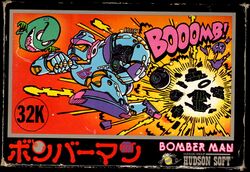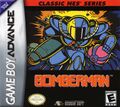mNo edit summary Tags: Mobile edit Mobile web edit |
m (cleanup) |
||
| (One intermediate revision by one other user not shown) | |||
| Line 1: | Line 1: | ||
{{Header Nav|game=Bomberman | {{Header Nav|game=Bomberman}} | ||
{{Game | {{Game | ||
|completion=4 | |||
|image=Bomberman FC box.jpg | |||
|title=Bomberman | |title=Bomberman | ||
| | |japanese=ボンバーマン | ||
|developer=[[Hudson Soft]] | |developer=[[Hudson Soft]] | ||
|publisher=[[Hudson Soft]] | |publisher=[[Hudson Soft]] | ||
| | |year=1985 | ||
|systems={{syslist|nes|msx|fds|gba|ngage}} | |||
|ratings={{ESRB|E}} | |||
|genre=[[Action]] | |genre=[[Action]] | ||
|players=1 | |players=1 | ||
| | |modes=[[Single player]] | ||
|followed by=[[Dyna Blaster]] | |followed by=[[Dyna Blaster]]<br />[[Bomberman II]] | ||
|series=Bomberman | |series=Bomberman | ||
}} | }} | ||
{{game disambig||the [[MS-DOS]], [[Commodore Amiga]], and [[TurboGrafx-16]] game|[[Dyna Blaster]]|the [[Nintendo DS]] game|[[Bomberman (Nintendo DS)]]}} | {{game disambig||the [[MS-DOS]], [[Commodore Amiga]], and [[TurboGrafx-16]] game|[[Dyna Blaster]]|the [[Nintendo DS]] game|[[Bomberman (Nintendo DS)]]}} | ||
The '''Bomberman''' series may be as well known to video game players as | The '''Bomberman''' series may be as well known to video game players as {{c|Mega Man}}, {{c|Castlevania}}, and even [[:Category:Mario|Super Mario]]. It has certainly been around as long. And like many of these other series, the first game is a rapid departure from what later games in the series would ultimately become, but the series as a whole is indebted to its roots for being a successful game in the first place. Although it didn't reach one million sales, it did sell a reported 800,000 copies throughout its lifetime. | ||
<gallery> | |||
File:Bomberman title.png|Title screen | |||
</gallery> | |||
The Bomberman series actually starts even before this particular [[NES]] game. A very simple, drastically different looking "Bomber Man" (according to the title screen) was released for the [[MSX]]. The gameplay was more abstract, featured only one enemy and no power-ups, and the only goal was to find the exit without dying. [[Hudson Soft]] dramatically improved the game for its Famicom release by adding a number of enemies, horizontally scrolling stages, and the power-ups that make keeping Bomberman alive so worthwhile. But they also made the first steps in shaping the Bomberman character that most people know and recognize today. The sprite used for Bomberman actually came from an enemy sprite used in Hudson Soft's very successful Famicom conversion of [[Lode Runner]]. One of the robotic enemies that chased the Lode Runner hero learned that he might become human if he can climb fifty underground floors to escape from his plant and reach the surface of the world. The only weapon at Bomberman's disposal, of course, are bombs. | |||
As a gift to the platform that Bomberman started on, Hudson Soft released an updated version for the MSX called '''Bomber Man Special''' that was updated to reflect the Famicom version. It was five years before Bomberman was followed up by two sequels, the first of which was actually made for the [[TurboGrafx-16]] in 1990. Outside of Japan, it was known as [[Dyna Blaster]], while in Japan it shared the same name as its predecessor even though it was a tremendously enhanced game. The second sequel was a proper NES sequel entitled [[Bomberman II]]. Subsequent releases on the TurboGrafx-16 and the series' debut on the [[Super Nintendo]] lead to the definition of the White Bomber character as a mainstay hero of the video game realm. In 2004, [[Nintendo]] gave Bomberman the distinction of being included in they Famicom Mini, and Classic NES lines of [[Game Boy Advance]] conversions. Hudson Soft re-released the game on the GBA along with Bomberman II in [[Hudson Best Collection Vol. 1]], published only in Japan. | |||
<gallery> | <gallery> | ||
File: | File:Bomberman NES box.jpg|NES box | ||
File: | File:Bomberman GBA box.jpg|GBA Classic NES box | ||
File: | File:Bomberman GBA JP box.jpg|GBA Famicom Mini box | ||
File:Hudson Best Collection Vol. 1 box.jpg|Hudson Best Collection Vol. 1 | File:Hudson Best Collection Vol. 1 box.jpg|Hudson Best Collection Vol. 1 | ||
</gallery> | </gallery> | ||
==Story== | ==Story== | ||
Our hero, Bomberman, worked in a bomb factory located in an underground labyrinth. | Our hero, Bomberman, worked in a bomb factory located in an underground labyrinth. He grew very bored making bombs day in and day out. One day, he learned of a rumor that stated if a robot could ever escape the labyrinth and reach the surface of the world, his wish would be granted and he would become human. Bomberman is determined to find out if this rumor is true. | ||
==Gameplay | ==Gameplay== | ||
* Bomberman starts each round in the upper left corner of every stage. | * Bomberman starts each round in the upper left corner of every stage. | ||
* Bomberman must first destroy every enemy in the stage, and second locate the exit and escape to the next stage. | * Bomberman must first destroy every enemy in the stage, and second locate the exit and escape to the next stage. | ||
* Bomberman can destroy enemies and walls with bombs. | * Bomberman can destroy enemies and walls with bombs. Bombs can also harm Bomberman unless he has a special power-up. | ||
* The number of bombs that Bomberman can deploy at one time, and the range of the explosions can be increased through power-ups. | * The number of bombs that Bomberman can deploy at one time, and the range of the explosions can be increased through power-ups. | ||
* Bomberman losses one life if he is touched by an enemy, or if he is caught in a bomb explosion. | * Bomberman losses one life if he is touched by an enemy, or if he is caught in a bomb explosion. | ||
* If Bomberman bombs the exit, or if he runs out of time, enemies will pour out of the exit. | * If Bomberman bombs the exit, or if he runs out of time, enemies will pour out of the exit. | ||
* Bombs ordinarily detonate on their own after a set amount of time. | * Bombs ordinarily detonate on their own after a set amount of time. One power-up gives Bomberman the ability to detonate the bombs at will. | ||
{{ToC}} | |||
{{Bomberman}} | {{Bomberman}} | ||
[[Category:Hudson Soft]] | [[Category:Hudson Soft]] | ||
[[Category:Action]] | [[Category:Action]] | ||
[[Category:Single player]] | [[Category:Single player]] | ||
Latest revision as of 21:51, 24 August 2022
This is the first game in the Bomberman series. For other games in the series see the Bomberman category.

| Bomberman | |
|---|---|
| Developer(s) | Hudson Soft |
| Publisher(s) | Hudson Soft |
| Year released | 1985 |
| System(s) | NES, MSX, Family Computer Disk System, Game Boy Advance, N-Gage |
| Followed by | Dyna Blaster Bomberman II |
| Series | Bomberman |
| Japanese title | ボンバーマン |
|---|---|
| Genre(s) | Action |
| Players | 1 |
| Modes | Single player |
| Rating(s) |
- For the MS-DOS, Commodore Amiga, and TurboGrafx-16 game, see Dyna Blaster. For the Nintendo DS game, see Bomberman (Nintendo DS).
The Bomberman series may be as well known to video game players as Mega Man, Castlevania, and even Super Mario. It has certainly been around as long. And like many of these other series, the first game is a rapid departure from what later games in the series would ultimately become, but the series as a whole is indebted to its roots for being a successful game in the first place. Although it didn't reach one million sales, it did sell a reported 800,000 copies throughout its lifetime.
-
Title screen
The Bomberman series actually starts even before this particular NES game. A very simple, drastically different looking "Bomber Man" (according to the title screen) was released for the MSX. The gameplay was more abstract, featured only one enemy and no power-ups, and the only goal was to find the exit without dying. Hudson Soft dramatically improved the game for its Famicom release by adding a number of enemies, horizontally scrolling stages, and the power-ups that make keeping Bomberman alive so worthwhile. But they also made the first steps in shaping the Bomberman character that most people know and recognize today. The sprite used for Bomberman actually came from an enemy sprite used in Hudson Soft's very successful Famicom conversion of Lode Runner. One of the robotic enemies that chased the Lode Runner hero learned that he might become human if he can climb fifty underground floors to escape from his plant and reach the surface of the world. The only weapon at Bomberman's disposal, of course, are bombs.
As a gift to the platform that Bomberman started on, Hudson Soft released an updated version for the MSX called Bomber Man Special that was updated to reflect the Famicom version. It was five years before Bomberman was followed up by two sequels, the first of which was actually made for the TurboGrafx-16 in 1990. Outside of Japan, it was known as Dyna Blaster, while in Japan it shared the same name as its predecessor even though it was a tremendously enhanced game. The second sequel was a proper NES sequel entitled Bomberman II. Subsequent releases on the TurboGrafx-16 and the series' debut on the Super Nintendo lead to the definition of the White Bomber character as a mainstay hero of the video game realm. In 2004, Nintendo gave Bomberman the distinction of being included in they Famicom Mini, and Classic NES lines of Game Boy Advance conversions. Hudson Soft re-released the game on the GBA along with Bomberman II in Hudson Best Collection Vol. 1, published only in Japan.
-
NES box
-
GBA Classic NES box
-
GBA Famicom Mini box
-
Hudson Best Collection Vol. 1
Story[edit]
Our hero, Bomberman, worked in a bomb factory located in an underground labyrinth. He grew very bored making bombs day in and day out. One day, he learned of a rumor that stated if a robot could ever escape the labyrinth and reach the surface of the world, his wish would be granted and he would become human. Bomberman is determined to find out if this rumor is true.
Gameplay[edit]
- Bomberman starts each round in the upper left corner of every stage.
- Bomberman must first destroy every enemy in the stage, and second locate the exit and escape to the next stage.
- Bomberman can destroy enemies and walls with bombs. Bombs can also harm Bomberman unless he has a special power-up.
- The number of bombs that Bomberman can deploy at one time, and the range of the explosions can be increased through power-ups.
- Bomberman losses one life if he is touched by an enemy, or if he is caught in a bomb explosion.
- If Bomberman bombs the exit, or if he runs out of time, enemies will pour out of the exit.
- Bombs ordinarily detonate on their own after a set amount of time. One power-up gives Bomberman the ability to detonate the bombs at will.




